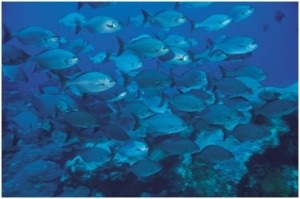Fish Farming in Kenya
Highly nutritious feeds are an absolutely necessity for success in aquaculture in Fish Farming in Kenya. A proper feeding regime ensures that fish are ready for sale in good time. Here are some tips on fish feeds:
-
Fertilizing the Pond
Fish farmers need fertilize their ponds before stocking. Fertilizers in a fish pond encourage green algae and plankton to grow and become fish farm feed. Fish farms are fertilized using either dung from farm animals (cows, chicken, sheep etc) or chemical fertilizers. During the first one month after stocking, fingerlings can feed on the algae and phytoplankton that will have developed in the pond. After that, they will need to be fed twice a day.
-
Using Locally Available Feed
A lot of readily available Feeds are suitable for fish. Fish can eat rice, wheat bran or maize. They can also eat sliced kales and chopped up sweet potato vines. Ants and termites, as well as left over fish can also be eaten by fish, as can fishmeal from smaller fish.
-
Using Droppings from Farm Animals
Fish farmers who have a chicken farm could think about putting up a chicken house on top of the fish pond and allowing chicken droppings to fall into the pond, which acts as fertilizer and feed for the fish. If the surface area of the pond measures 10 meters squared, 10 chickens are enough for this. Pig farmers can put up pigsties near the pond so that pig manure can be washed into the fish. Take care to avoid over fertilization.
-
Using Manufactured Feeds
Fish farms in Africa generally do not have reliable access to manufactured feeds. Sometimes large scale fish farming operations which produce their own feeds may have excess feed which they sell to small scale fish farmers. Usually, fish feed comes in form of meal, crumble; and pellets which can be dry sinking, floating or moist sinking.
The ideal formulas may contain some cottonseed cake, more than 50% wheat bran, freshwater shrimp, and a little vitamin mix.
-
Mixing Your own Feeds
There is always the option of mixing your own feed. One mixture that is affordable is mostly made up of rice bran with about 25% fishmeal. Alternatively, dried freshwater shrimp can be joined together with fishmeal and maize bran. The ingredients are ground using a grinder, then mixed by hand in a mixer and finally made into pellets.
-
Storing Your Fish Farm Feed
Always store fish feed in a cool and dry place. This will help to keep the feed from spoiling. Do not buy too much feed, or it may expire before it is consumed.
-
Regulating Fish Feeds
Keep track of the population in the fish farm and weigh the fish every two weeks to ensure that fish are not underfed or overfed. The amount of feed should be proportional to the number of fish and their body weight for Fish Farming in Kenya. Reduce the amount of fish if you notice fish are not consuming the feed and if temperatures have gone higher. Feeding should be gradual, bear in mind that tilapia are browsers – they feed all day long, so don’t drop all the days feed in the pond at once.
Feed fish between 10am and 4pm because at that time, the temperatures are high and so is the dissolved oxygen level. Try to always drop feed at the same place everyday so that fish know where to find Feed.
-
Feeding Your Fish
There are different ways of feeding fish for Fish Farming in Kenya. Try broadcast method by dispersing feed into the water. The feed can also be placed on a table in the water or an automatic feeder can be used to broadcast feed at set times during the day. Feeding by hand allows the farmer to monitor the health and growth of the fish. If they are not eating excitedly, they may not be healthy.
Other Article of Interest

Comments